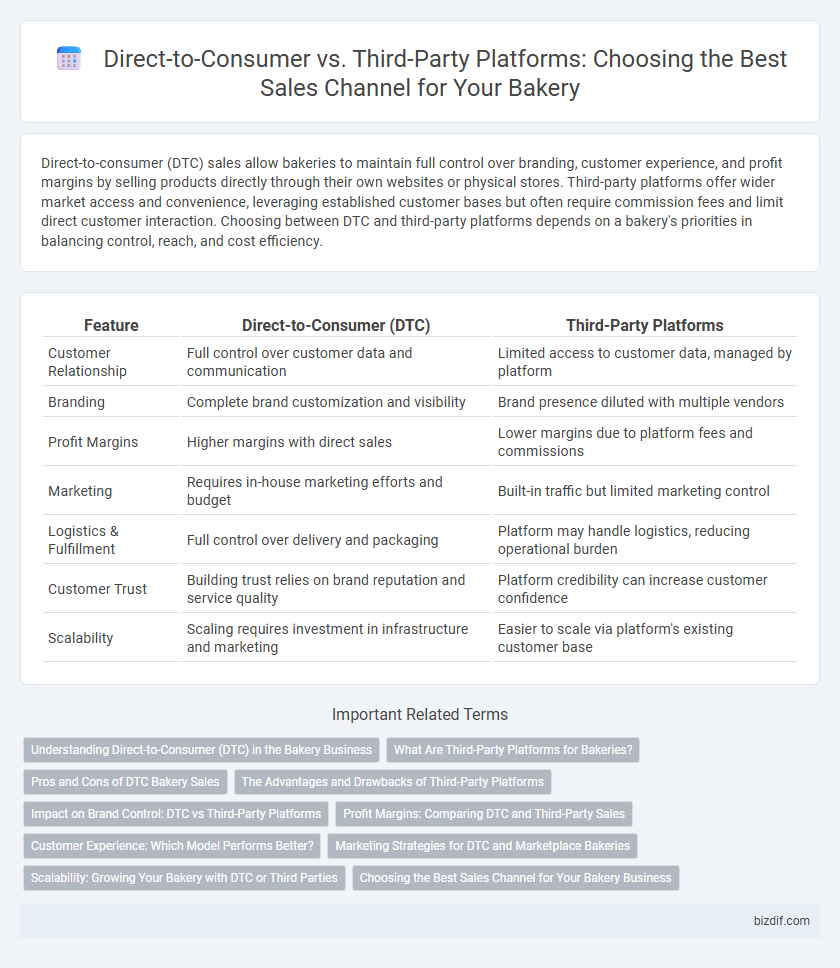Direct-to-consumer (DTC) sales allow bakeries to maintain full control over branding, customer experience, and profit margins by selling products directly through their own websites or physical stores. Third-party platforms offer wider market access and convenience, leveraging established customer bases but often require commission fees and limit direct customer interaction. Choosing between DTC and third-party platforms depends on a bakery's priorities in balancing control, reach, and cost efficiency.
Table of Comparison
| Feature | Direct-to-Consumer (DTC) | Third-Party Platforms |
|---|---|---|
| Customer Relationship | Full control over customer data and communication | Limited access to customer data, managed by platform |
| Branding | Complete brand customization and visibility | Brand presence diluted with multiple vendors |
| Profit Margins | Higher margins with direct sales | Lower margins due to platform fees and commissions |
| Marketing | Requires in-house marketing efforts and budget | Built-in traffic but limited marketing control |
| Logistics & Fulfillment | Full control over delivery and packaging | Platform may handle logistics, reducing operational burden |
| Customer Trust | Building trust relies on brand reputation and service quality | Platform credibility can increase customer confidence |
| Scalability | Scaling requires investment in infrastructure and marketing | Easier to scale via platform's existing customer base |
Understanding Direct-to-Consumer (DTC) in the Bakery Business
Direct-to-Consumer (DTC) in the bakery business enables brands to build direct relationships with customers, enhancing brand loyalty and capturing valuable consumer data for personalized marketing. By controlling the entire customer experience--from order placement to delivery--bakeries can ensure product quality and customize offerings based on direct feedback. This model reduces reliance on third-party platforms, increasing profit margins by eliminating intermediary fees and streamlining supply chain operations.
What Are Third-Party Platforms for Bakeries?
Third-party platforms for bakeries are online marketplaces or delivery services that connect bakeries with customers outside their own websites or physical stores, such as Uber Eats, DoorDash, and Grubhub. These platforms handle order processing, payment, and delivery logistics, enabling bakeries to reach a wider audience without managing the infrastructure themselves. While they increase visibility and sales opportunities, third-party platforms typically charge commissions and fees, impacting overall profit margins.
Pros and Cons of DTC Bakery Sales
Direct-to-Consumer (DTC) bakery sales offer higher profit margins by eliminating third-party fees and enable direct customer engagement, fostering brand loyalty and personalized experiences. However, DTC requires investment in e-commerce infrastructure, marketing, and logistics, posing challenges in scaling and customer acquisition. Without third-party platform support, bakeries must manage order fulfillment and customer service independently, potentially increasing operational complexity.
The Advantages and Drawbacks of Third-Party Platforms
Third-party platforms offer bakeries increased visibility and access to a broader customer base without the need for heavy marketing investments. These platforms handle logistics such as payment processing and delivery, simplifying operations but often charge significant fees that reduce profit margins. Reliance on third-party services can limit brand control and customer relationship management, potentially impacting long-term loyalty and personalized marketing efforts.
Impact on Brand Control: DTC vs Third-Party Platforms
Direct-to-consumer (DTC) platforms give bakeries full control over brand presentation, customer experience, and pricing strategies, enhancing brand loyalty and consistent messaging. Third-party platforms often limit customization options and impose uniform branding, which can dilute the bakery's unique identity and reduce direct customer engagement. By bypassing intermediaries, bakeries on DTC channels can gather valuable consumer data for targeted marketing, while third-party platforms restrict access to customer insights.
Profit Margins: Comparing DTC and Third-Party Sales
Direct-to-Consumer (DTC) sales in the bakery industry offer higher profit margins by eliminating middlemen and reducing commission fees typically charged by third-party platforms such as Uber Eats or Grubhub. While third-party platforms expand customer reach and convenience, they often take 20-30% of the sale price, significantly cutting into bakery profits. Bakeries focusing on DTC strategies benefit from full control over pricing, branding, and customer data, ultimately enhancing long-term profitability and customer loyalty.
Customer Experience: Which Model Performs Better?
Direct-to-consumer bakery sales often provide a superior customer experience by enabling personalized interactions, fresher product delivery, and direct feedback channels. Third-party platforms offer convenience and broader reach but may compromise freshness and limit customization options due to indirect service layers. Data shows that bakeries utilizing direct-to-consumer models report higher customer satisfaction scores and repeat purchase rates.
Marketing Strategies for DTC and Marketplace Bakeries
Direct-to-consumer (DTC) bakery brands leverage personalized social media campaigns and email marketing to build strong customer loyalty and collect valuable first-party data, enhancing targeted promotions and repeat sales. Third-party marketplace bakeries benefit from wider reach and established traffic by utilizing platform-sponsored ads and customer review management to boost visibility and credibility. Optimizing SEO-rich product descriptions and leveraging influencer partnerships are key strategies that drive sales for both DTC and marketplace bakery businesses.
Scalability: Growing Your Bakery with DTC or Third Parties
Direct-to-consumer (DTC) platforms enable bakeries to scale by building direct relationships with customers, offering personalized products and higher profit margins. Third-party platforms provide immediate access to a broader customer base and established delivery logistics, accelerating market reach with minimal upfront investment. Choosing between DTC and third-party solutions depends on balancing control, brand loyalty, and the speed of scaling operations in the competitive bakery industry.
Choosing the Best Sales Channel for Your Bakery Business
Direct-to-consumer sales channels offer bakeries greater control over branding, customer data, and profit margins, facilitating personalized marketing strategies and stronger customer relationships. Third-party platforms provide immediate access to a broader audience and reduce logistics complexity but often involve higher fees and less control over the customer experience. Evaluating factors such as cost structure, marketing capabilities, and long-term growth potential helps bakery owners select the optimal sales channel to maximize revenue and brand loyalty.
Direct-to-Consumer vs Third-Party Platforms Infographic

 bizdif.com
bizdif.com